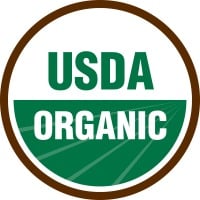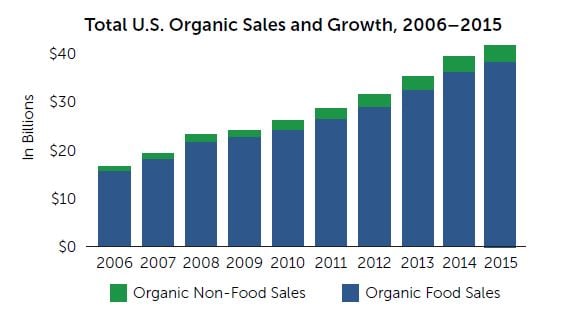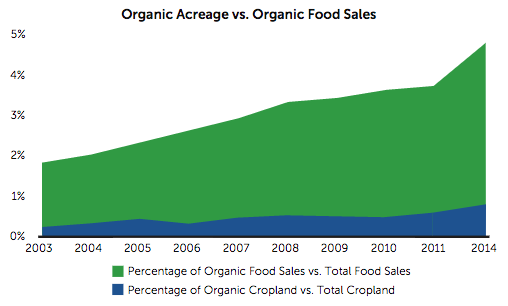 It’s no surprise to hear that organic products are in high demand. So it only goes to say that organic ingredients that make up those products are in high demand too.
It’s no surprise to hear that organic products are in high demand. So it only goes to say that organic ingredients that make up those products are in high demand too.
But can the supply keep up with this growing demand?
These big questions related to the organic supply chain are front-of-mind for many natural food manufacturers like you: Can your growing demand for organic ingredients be met? Can the supply chain keep up? And will you run into any ingredient shortages?
Today, we’ll look closely at the organic supply and demand, and touch on the organic oil market in particular.
Organic Demand Grows
In the last 18 years, organic sales have increased from $3.6 billion in 1997 to $43.3 billion in 2015. That’s an increase of 12x the average sales 18 years ago, so it’s safe to say that organic is not a short term consumer fad.
Last year, the organic sales growth rate was 10.8% (in 2015), while the rest of the conventional food market grew at an overall rate of 3.3%. Source

Image Source: OTA
Right now, organic food sales makes up about 5% of the market, but some, like Annie’s president John Foraker, predict that sales will grow up to 20%.
Foraker says, “I think that the natural products industry will move to organic. That’s where it’s going and it’s what consumers want. Today, 4-5% of the market is organic and I think it will ultimately get to 20%.” Source
Organic Supply Struggles To Keep Up
With how much the organic market is in demand, the US-grown supply chain is struggling to keep up. While organic food sales currently make up nearly five percent of total food sales, acreage devoted to organic agriculture in the US is less than one percent of total cropland.

Image Source: OTA
A temporarily tight supply chain is a common challenge when demand for a particular product is on the rise — the sudden surge in demand impacts supply significantly, sometimes driving prices upwards with a lack of available inventory.
As a result, many organic products have been imported into the US to help support our fast-growing demand. The U.S. imported $184 million in organic soybeans and $35 million in organic corn in 2014. Source
For example in the organic oil world, many of Centra’s organic edible oils are from a mixture of US origin and other imported origins. This helps secure the supply chain and keep up with the growing demand.
In the long term, this high growth in demand also helps push farmers in the US to invest in organic.
Organic Future Supply In The US Is On The Rise
According to the USDA figures, there were a record number of certified organic operations (19,474) in the US in 2014. The Organic Trade Association (OTA) reported that there were another 3,000 farms transitioning to organic. Source
On top of that, the OTA is working hard in 2016 to increase US organic acreage and production of products to ease the supply chain pinch. One avenue that they are working on is creating a “transition program” or seal for farmers transitioning to organic.
“To become certified organic, farmers must meet organic standards for three years, during which they will likely see lower yields than conventional farming but currently cannot demand the higher price premium of organic. This creates a disincentive for farmers to switch to organic, which in turn hinders the industry’s ability to meet demand.” Source
As a solution to this, they are working to create an Organic Transitioning program, to help ease the financial burden of making the switch from conventional to organic and lower the barrier of entry for farmers.
According to the Organic and Non-GMO Report, this Organic Transition Certification is now officially available through Clarkson Grain.
Demand & Supply Of Organic Oil Ingredients
With organic oils in particular, demand has been on a significant increase over the last 5 years. Many more brands have entered the natural foods market, launching new organic product lines — especially snacks — that often require oils.
In the last 2-3 years, mainstream brands have also been developing off-shoot organic product lines which require higher volumes of organic oils and put more strain on the organic supply chain. Years ago, the organic market was dominated by many small companies that had smaller sales and small demand for ingredients. When large brands join in to compete for market share, they can drastically upset the balance of supply and demand as they buy up larger chunks of available stock.
At this time, the organic oil ingredient market is tight due to gradually increasing demand, but not in crisis. My personal recommendation would be for brands to contract in their supply needs and diversify their supply base to make sure that their oil needs are fully covered.
While it’s always an option to ride the spot market with organic products, there’s always the chance that a large player could develop a new line and upset the balance of available stock at any time.
Topics: Organic, Harvest/Commodity Market












